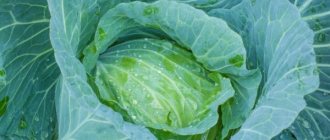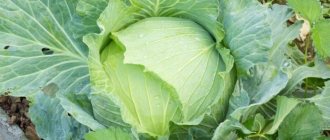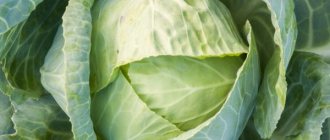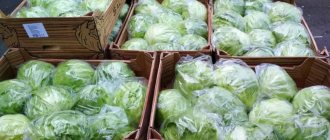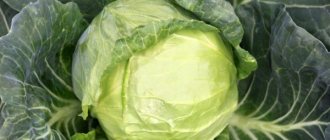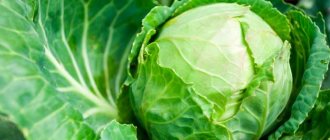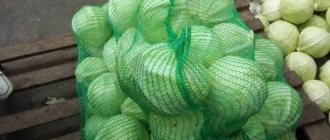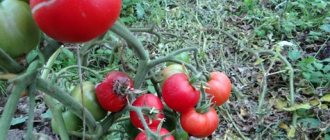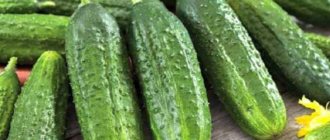Vegetable growing » Cabbage
0
1466
Article rating
Kira Stoletova
Gribovskaya cabbage is a popular variety that is grown in almost all garden plots. It is ideal for long-term storage and transportation.
Description of cabbage variety Gribovskaya
Cabbage variety Number one Gribovsky 147
The variety was developed by the All-Union Research Institute for Selection and Seed Production of Vegetable Crops using the method of family selection from a German hybrid species.
They started breeding in 1940.
Cabbage Number One Gribovsky 147 is early ripening, not a hybrid.
Popular variety in Russia.
Description of the variety with photo
- A plant with a neat half-raised rosette, the leaf is small, sessile (without petioles), the plate is smooth.
- Productivity - 6.7-8.5 kilos per m2.
- Collection is completed in 21 days.
- Grown in open ground.
- Ripens 100 days after germination of seedlings.
- Head of cabbage: short oval, round, not large, with a short stalk inside.
- Fork weight - up to 2 kilos.
- The taste is good, it contains a lot of ascorbic acid.
- There is no resistance to cracking. To prevent it, pruning is required.
Delicious cabbage, suitable for fresh consumption. Can be consumed in salads and other dishes.
Growing regions
The vegetable is especially valued for making baby food and diet food. The variety grows well in all regions of Russia, as well as in the following areas:
- Belarus.
- Uzbekistan.
- Kazakhstan.
- Georgia.
- Azerbaijan.
- Lithuania.
- Latvia.
- Kyrgyzstan.
- Tajikistan.
- Armenia.
- Turkmenistan.
- Estonia.
Growing technology
Vegetable seedlings must be grown in heated greenhouses.
The process takes place in stages:
- Soil treatment.
- Fertilizer application.
- Planting seedlings.
- Care: loosening, watering, hilling, feeding, weeding, prevention and control of diseases and pests.
- Harvesting.
- Storage.
The most fertile substrate is suitable for early types of cabbage.
The preparatory process starts with autumn digging to a depth of approximately 200 mm.
It involves cultivating the soil in the fall for sowing spring crops in the spring.
With the help of digging you can really regulate the moisture level of the soil.
At the beginning of spring, the soil is plowed.
Depth affects the development of vegetable roots.
The earlier the plowing is done, the higher the yield will be.
In the northern regions, on soils with a low soil layer height, as well as in areas with reduced relief and high moisture levels in the middle zone, the vegetable is grown on ridges that are cut after plowing in the spring.
By feeding exclusively with mineral compounds, it is possible to harvest a high-quality vegetable harvest on fertile floodplains, areas with reduced relief, or on peat areas that have been drained.
On the least fertile soil, it is necessary to add organic matter.
A slightly acidic soil environment is well suited for cabbage.
For full growth of cabbage, it must consume 1 part phosphorus, 2.8 parts nitrogen and 3.4 parts potassium substances.
Fertilizing with manure, the vegetable absorbs in 12 months:
Therefore, deficient potassium and especially nitrogenous substances must be added as minerals during the ovary of the vegetable.
- Bedding
Depending on the climate of the region, the seedlings are sent to the garden during the days of May. Planted in the evening or on a cloudy day.
After the seedlings are planted, they need to be watered.
The distance between the rows should not be less than 600 mm.
The interval between seedlings in a row for early cabbage is approximately 400 mm.
Description of the variety
Cabbage is grown from seedlings. Technical ripeness is noted 2 months after planting seedlings in open ground. Seedlings are grown in greenhouse conditions for 30 days. Gribovsky variety cabbage is cultivated in all regions of Russia, Belarus, Transcaucasia, and the Baltic states:
- The cabbage bush is compact and does not require much space in the garden. When planting in open ground, adhere to the 50*50 cm pattern;
- leaves are bright green. They form a powerful socket. It is directed upward, which allows the soil to be well ventilated. A disease such as cabbage clubroot rarely develops in the crop. Slimy bacteriosis is not typical for the plant;
- the root is short but branched, so the plant can tolerate dry periods, but gardeners do not recommend drying out the soil;
- early cabbage tolerates short-term frosts, temperature changes, and precipitation;
- it is not attacked by insects;
- The average weight of a head of cabbage is 2 kg. The inner leaves are light green. Medium density forks;
- subject to optimal planting density, up to 8 kg of vegetables are harvested from 1 m2;
- the crop grows well on fertile loams.
Experts note an increased content of ascorbic acid in the Gribovsky 147 variety, more than 41 mg/100 g of product. Sugar 4.6%. Calorie content 30 kcal. Cabbage is used to prepare vitamin salads. It is stored at a temperature of 2-5 C, no more than 2 months. Vegetables are meant to be used quickly.
Characteristics of the variety
Cabbage number one Gribovsky 147 was bred in Russia. According to the description, it can be grown in all regions of the country. Resistance to drought and high air humidity is noted.
The variety is early ripening. The growing season of the variety is only 60 days from the moment the seedlings are planted in open ground.
- compact leaf rosette: diameter 60 cm;
- the leaves are whole, light green in color, completely covered with a waxy coating, the leaf length is about 20 cm and the width is 30 cm;
- round head of cabbage, weight 3 kg, light green color;
- dry matter is about 8%;
- sugar level 5%;
- contains vitamins C;
- the yield is high: from 1 m2 you can collect about 7 kg of selected products.
It is believed that the Gribovsky variety becomes tastier when stored for a long time. It can be used both fresh and pickled. Borscht, cabbage soup, stews or fresh salads are often prepared from this culture.
Landing
On an industrial scale, seedlings are planted in heated greenhouse structures. Compost 7-8 kg per 1 m2, phosphorus-potassium additives (40-50 g), peat for looseness on clay soils are added to the beds. The optimal pH for cabbage is in the range of 5.5-7 (neutral or slightly acidic). For acidic soils, liming is carried out once every 3-4 years.
The planting density on the site is 4 bushes per 1 m2. The distance between vegetables is 60 cm.
Add to the holes when planting:
- 1 scoop of compost;
- 1 tbsp. ash;
- 1 tsp superphosphate.
Seedlings from peat pots are carefully buried in a hole 3-4 cm below the top edge.
Features of cultivation
It is grown exclusively by seedlings, so in early March you need to plant the seeds to obtain seedlings. Planting material of this variety does not require pre-treatment or disinfection.
It is recommended to plant seeds in a container at a distance of 5 cm from each other. After this, the container is placed in a warm place, with a temperature of 20-24°C. In such conditions, germination occurs much faster. As soon as the first shoots appear, the daytime temperature should be 17°C, and the night temperature 8-10°C.
After 30 days, when the seedlings have formed 2 pairs of leaves, they can be planted in open ground. The procedure is carried out at the end of April or beginning of May. It is important to think about the landing site in advance. This variety needs fertile and light soils, with a low acid-base balance (no more than 5%). The distance between bushes should be 60 cm, and between rows about 70 cm.
Features of planting and growing
Slava cabbage is grown in seedlings and without seedlings. In the first case, the seeds are initially planted in small boxes, and in the second - immediately in open ground.
Preparation
Before planting it is recommended:
- Place the seeds in water at a temperature of +55...+60°C for 15 minutes.
- Then immerse them in cool water for 1 minute.
- Prepare a solution: use 12 g of potassium humate per 10 liters of water.
- Pour the mixture over the seeds and leave for 12 hours.
- After the specified time, dry the planting material and place it in a cool place.
After a day, the seeds can be planted.
How to plant without seedlings
With the seedless method:
- Sow the seeds in the soil to a depth of 2 cm.
- Thin out the seedlings after the formation of 3 leaves.
- Repeat the procedure after the 6th leaf appears, leaving 60 cm between the sprouts.
Soil requirements
Any soil is suitable for growing Slava cabbage. But it is recommended to choose fertile loamy soil with close groundwater. The recommended soil acidity indicator is ph=6.7-7.4.
Attention! The time interval between planting cabbage on the same piece of land should be at least 3-4 years.
Dates, scheme and rules of planting
To grow seedlings, seeds are sown in boxes in early April. With the seedless method, seeds are planted in open ground in the third ten days of April. In the south they are sown after March 25th.
The scheme for planting seedlings in the soil is 60x60 cm.
In most regions of Russia, the seedling method is used. Landing instructions:
- Prepare boxes 5-6 cm deep.
- Pour soil into containers.
- Compact the soil and treat with a solution of potassium permanganate.
- After three days, make furrows 1 cm deep at a distance of 3 cm from each other.
- Sow the seeds.
- Cover the crops with soil and water.
- Place the boxes in a warm place until shoots emerge. Temperature range: +18…+20°C.
- After the sprouts appear, move the boxes to a lighted windowsill. Maintain the temperature within +10…+12°C. Otherwise, the sprouts will quickly stretch upward, which is dangerous due to deformation and death of the plant.
- After the formation of 5 leaves, plant the seedlings in open ground.
Features of cultivation
Often, when growing cabbage, mistakes are made that lead to the formation of a shoot. To avoid this, take into account the characteristics of the growing season of the crop and do not allow:
- dense planting of seedlings;
- lack of lighting;
- excess moisture.
To obtain a bountiful harvest, plantings are regularly cared for:
- Watering. Slava cabbage loves moisture, so it is watered about 8 times a month.
- Loosening. It is performed after each watering to ensure access of oxygen to the root system of the plant.
- Hilling. The procedure helps the formation of root shoots. As a result, the plant will receive more nutrients.
- Feeding. Nitrogen fertilizers are applied 15 days after planting. During the formation of heads of cabbage, the plant requires phosphorus and potassium supplements.
Disease and pest control
The most common disease is blackleg. The disease begins to develop in the root system and can occur even at the initial stage of growth, so the seeds are disinfected before planting. During the growth process, the soil is loosened, first sprinkled with ash.
If infection has already occurred, treatment is carried out with the drugs “Fitoflavin”, “Baktofit”, “Trichodermin”.
The source of pests may be a neighboring area. The greatest damage to cabbage is caused by aphids. Massive spread may be contained by cool weather and heavy rains. To combat aphids, dill and parsley are planted next to cabbage. These crops are attractive to ladybugs that feed on aphids. For treatment purposes, the beds are sprayed with tobacco decoction or a vinegar solution (200 ml of substance and 40 g of soap per bucket of water). Popular drugs for getting rid of aphids are “Fitoverm”, “Iskra”, “Aktara”.
Cabbage moths often settle in beds. Signs of damage: damaged and drying leaves, yellow spots, lack of growth, rotting of the plant. In this case, complex treatment is carried out with insecticides “Aktellik”, “Ambush”, “Talcord”.
To reduce the risk of diseases, before planting the soil is treated with lime in a volume of 1 kg per 4 m².
Difficulties in growing
Sometimes vegetable growers are faced with a problem: cabbage heads do not form. The plant actively stretches upward and overgrows with leaves. The reasons may be:
- late sowing;
- dense planting;
- violation of the watering regime;
- excess nitrogen fertilizers during the period of fork formation.
With proper care, white cabbage Slava always produces dense heads of cabbage.
Care instructions
Plants need good care
Cabbage Gribovskaya 147 needs full care (watering, weeding and fertilizing). It is recommended to water in the morning so that the sun does not evaporate too much moisture. It is better to use warm water, as it increases the adhesion of the roots to the soil. About 3 liters of water should be poured under each bush. Interval 4-6 days.
After each watering, it is important to loosen the soil and remove weeds. These procedures not only allow you to get rid of the top crust caused by heat and moisture, but also prevent parasites. Removing the crust allows nutrients and oxygen to better pass into the roots.
Fertilizing is carried out twice during the entire growing season.
- 25 days after planting the seedlings in open ground. You need to prepare a solution of organic substances (2 kg of humus per 10 liters of water). At least 2 liters of the drug is poured under each bush.
- At the beginning of flowering. It is advisable to apply mineral fertilizers (20 mg of superphosphate or 10 mg of potassium nitrate per 10 liters of water). Pour at least 3 liters of solution into each bush.
Parasites and diseases
Diseases of this variety are clubroot and vascular bacteriosis.
Clubroot can be cured by spraying with a solution of Bordeaux mixture (2 mg per 10 liters of water). You can get rid of vascular bacteriosis only with the help of chemical insecticides - Regent or Taboo. The solution is prepared in a ratio of 20 mg of the substance per 10 liters of water. Spray the area every 10 days.
The main pests include fleas and aphids. You can get rid of fleas using colloidal salt (10 mg per 10 liters of water), which is sprayed, and in the fight against aphids you should use the copper-containing drug Oxychom (40 ml per 10 liters of water).
Cabbage Gribovskaya
The ancient Egyptians prepared delicious dishes from white cabbage and served them for dessert. The inhabitants of Egypt believed that this plant had powerful healing powers that could cure various diseases. Today, humanity relies more on modern medicines, but the benefits of cabbage are still unquestioned. Russia has its own favorite, time-tested varieties of vegetables. This list can safely include cabbage Number One Gribovsky 147 or simply Gribovskaya, as it is most often called.
Brief characteristics of the crop, history of the variety
White cabbage is the most common and popular member of the cabbage family. This cross-pollinated biennial plant is a cold-hardy crop. +5°C is sufficient for seed germination, and seedlings planted in a garden bed can easily withstand frosts down to 3-4°C. During the growth process, a temperature of 14-16°C is enough for it; for an adult plant, the optimal temperature will be 18-20°C.
Note! In hot weather and low humidity, cabbage greatly slows down its growth.
The crop grows successfully on any soil except sandy soil. It needs soil that is moisture-intensive and fertile. The roots of this vegetable are weak and rather superficial. Most varieties have a noticeable waxy coating on the leaves. According to the timing of ripening, the vegetable is divided into early and late varieties.
Advice! It is recommended to plant cabbage in an open, well-lit place; in such conditions it will grow better and be less susceptible to attacks by pests.
The Gribovsky cabbage variety was added to the State Register back in 1940 and has been loved by summer residents for many decades. We worked on its creation at the Research Institute of Selection and Seed Production of Vegetable Crops. The basis was a German-made hybrid. According to the description, the variety is suitable for cultivation in all regions of Russia.
Description of Gribovskaya cabbage
Gribovskaya is considered one of the best varietal varieties of early cabbage. The growing season lasts 60 days from the moment the seedlings are planted in open ground. Cabbage has the following characteristics:
- leaves are light green in color with a waxy coating, medium-sized;
- forms a white head of round shape and medium density weighing 1-2 kg;
- semi-raised leaf rosette, 60 cm in diameter;
- sugar content - 5%;
- yield indicator - 7 kg per 1 sq. m.
- prone to clubroot and vascular bacteriosis.
The best early white cabbage
Experienced gardeners and farmers prefer to grow universal varieties.
Universal varieties
Their main characteristics include the plants’ unpretentiousness to weather conditions and frost resistance.
Early white cabbage Golden Hectare is widely known to gardeners in our country
Table: universal varieties of cabbage
| Variety | Name | Vegetative period, days | Head weight, kg | Productivity, kg/m2 |
| Early | June | 90–110 | 1–1,5 | 2–6 |
| Cossack F1 | 90–110 | 0,8–1,7 | 3,5–5 | |
| Number one Gribovsky 147 | 100–110 | 0,9–3 | 2,5–6,7 | |
| Golden hectare 1432 | 100–110 | 1,6–3,3 | 5–8 | |
| Transfer F1 | 90–100 | 0.7–1.5 | 7 |
Let's take a closer look at some of these varieties.
June
Early ripe cabbage. The growing season is 90–110 days. Growing area - all regions of Russia, Moldova, Ukraine.
The June cabbage variety is grown in all regions of Russia
Features of the variety:
- The rosette is compact, up to 40–50 cm.
- The leaves are light green, semi-raised.
- The head is round, of medium density. Lowly susceptible to cracking.
- Harmonious ripening of vegetables.
- Withstands frosts down to -5°.
- Resistant to the invasion of cross-shaped flea beetle and cabbage fly.
Number one Gribovsky 147
The variety is early ripening. The ripening period from sowing seedlings to harvesting is 100–110 days. Zoned throughout the Russian Federation.
White cabbage variety Gribovsky 147 is zoned throughout Russia
Main characteristics:
- A medium-sized rosette of cabbage is 40–80 cm.
- The leaves are green with a slight waxy coating, semi-raised.
- The head of cabbage is round, short oval with a delicate internal structure. Susceptible to cracking.
- Harmonious ripening of vegetables.
- The variety is drought and frost resistant.
- Susceptible to clubroot and vascular bacteriosis.
Transfer
This is an early hybrid. The ripening period is 90–100 days. Recommended for cultivation in all climatic zones of Russia.
The early hybrid Transfer has proven itself well in garden plots across the country
Originality of the variety:
- The cabbage rosette is compact, up to 40 cm.
- The leaves are light green, semi-raised, bubbly with a slight waxy coating.
- The head of cabbage is round and loose. Not subject to cracking.
- Withstands frosts down to -5°.
- Transports well.
- Resistant to diseases and pests.
Popular varieties in Russian regions
But there are also specially bred varieties of cabbage for different climatic zones.
Variety Number One Polar K-206 was developed specifically for regions with unstable cold climates
In our country there are 342 varieties and hybrids of this crop. We invite you to get acquainted with popular varieties that have been tested in local conditions and showed good results.
Table: zoned white cabbage
| Variety | Region | Name | Vegetative period, days | Head weight, kg | Peculiarities |
| Early | Moscow region and central Russia | Dumas F1 | 90 | 1,5 | Tolerates thickened plantings well. |
| Express F1 | 70–90 | 0,9–1,3 | Resistant to flowering and cracking of heads of cabbage. | ||
| Baroque | 85–90 | 0,9–1,1 | The heads of cabbage do not crack. | ||
| Ditmarskaya | 100–110 | 1,5–2 | Prone to over-ripening, the crop should be harvested in a timely manner. | ||
| Dot | 100–115 | 0,9–1,2 | Transports well. | ||
| North-West region | Solo F1 | 85–94 | 1.2–1.5 | Resistant to vascular bacteriosis. Susceptibility to clubroot is average. | |
| Start F1 | 85–94 | 1,2–1,5 | Resistant to pathogens of major diseases. | ||
| Siberia and the Urals | Nozomi F1 | 80–100 | 1–1,8 | Cold-resistant. Withstands excessive moisture, resistant to blackleg and bacteriosis. Vegetables do not crack. | |
| Skorospelka | 85–102 | 0,9–1,3 | |||
| Polar region F1 | 90–97 | 1–1,5 | |||
| Malachite F1 | 90–130 | 1,3–1,5 | |||
| Number one Polar K-206 | 100–110 | 1,6–3,2 | |||
| South Region | Sugar crunch | 80–90 | 0,7–2 | Excellent taste and product quality. | |
| Asian Express F1 | 95–100 | 1,5–2 | Immune to vascular bacteriosis. Vegetables do not crack. | ||
| Derbent local improved | 80–114 | 0,7–2 | Susceptible to bacteriosis. | ||
| Farao | 90–100 | 1,4–2 | Resistant to Fusarium wilt. | ||
| Far East | Surprise F1 | 90–100 | 1–1,5 | Harmonious ripening of the crop. The head of cabbage does not crack. | |
| Zephyr F1 | 95–115 | 1,5 | Juicy and sugary taste of vegetables. Resistant to flowering and disease. |
Video: review of new varieties and hybrids of early white cabbage
Aelita, Manul, Gavrish, SeDeK, Poisk, Russian Ogorod-NK, Akvarel are the main seed producers in Russia
Buy high-quality seed material from manufacturers and their official dealers. The following agricultural firms are widely known in Russia: Aelita, Manul, Gavrish, SeDeK, Poisk, Russian Ogorod-NK, Akvarel, etc.
Growing seedlings
This varietal variety is recommended to be grown only by seedlings. Seeds are sown in early March. The seed does not require any preliminary preparation.
The seeds are planted in the planting container at a distance of 5 cm from each other. After this, the container with seedlings is kept at a temperature of 20-24°C until germination.
On a note! In a warm room this process occurs faster.
When the sprouts appear, it is recommended to reduce the temperature in the room to 17°C during the day and 10°C at night.
At home, seedlings should be kept for 1 month. After the appearance of 4 true leaves, the seedlings can be transplanted into open ground. This moment comes at the end of April or beginning of May. The soil in the garden bed should be loose and fertile, with a slightly acidic reaction. In the row, 60 cm should be left between plants; the gaps between rows are recommended to be 70 cm wide.
Basic growing rules
When is it sown in different regions?
The early ripening variety Gribovsky 147 is grown only by seedlings, so seeds are sown for seedlings:
- in the southern regions - from the end of February to the first days of March;
- in central Russia - from March 20;
- in the Urals and Siberia - in early April.
Planting seedlings
Mushroom cabbage is a variety, not a hybrid, so you can grow it from your own planting material.
Before planting, seeds must be rejected for hollowness and calibrated, leaving grains of medium and large sizes. Rejection can be combined with disinfection. To do this, pour the seeds into a container with a solution of potassium permanganate for 30 minutes.
The seeds remaining on the surface are thrown away, and the rest are prepared for sowing in 3 stages:
- The grains are immersed in hot water (50°C) for 20 minutes and then in cold water for 5 minutes (to increase resistance to fungal diseases).
- The seeds are kept for 12 hours in a solution of microelements (any growth stimulant can be used).
- The seed is placed for a day in the lower zone of the refrigerator (stratified).
Substrate for seedlings can be purchased at the store, but it is easy to prepare yourself. To do this, mix equal parts of turf soil and peat with the addition of 10% wood ash. The resulting mixture is disinfected with a solution of potassium permanganate or calcined in the oven.
The Gribovsky 147 variety has a delicate root system, so it is better to grow seedlings without picking. Seeds are sown in common trays.
Attention!
Trays must be disinfected with a solution of potassium permanganate.
Furrows are made in the soil at a distance of 3 cm and a depth of 1-1.5 cm, into which seeds are placed in increments of 2 cm. The grooves are covered with a thin layer of soil, slightly compacted, watered with warm, settled water from a spray bottle, covered with plastic film and placed in dark warm place (20-22°C).
Care
After the first shoots appear, the film is removed, and the trays with seedlings are placed in a well-lit place with a temperature of 6-8°C for 5-7 days.
This promotes the development of the root system and protects the seedlings from being pulled out. Approximately on the 10th day after germination, the seedlings are thinned out, leaving a distance of 5-6 cm between the best seedlings. The most favorable temperatures for growing seedlings after primary hardening are:
- during the day – 16-18°C;
- at night – 8-10°C.
Water the seedlings with a spray bottle as the soil dries. 10 days before planting seedlings in open ground, they begin to harden them by taking them out into the open air and gradually increasing the time spent in it. Seedlings are considered ready for transplanting when 4-5 true leaves are fully formed.
Moving to open ground
The site for transplantation is selected and prepared in the fall. The place should be sunny, with well-fertilized loamy, non-acidic soil. Also, when choosing a site, crop rotation rules are taken into account. Cabbage grows well after legumes, beets, potatoes, tomatoes and cucumbers.
Important!
In the place where cruciferous crops grew, the variety Gribovsky 147, due to its susceptibility to clubroot, can only be planted after 4 years.
The seedlings are transplanted into open ground from mid-May using the square-cluster method (50x50). In holes made so that the root of the transplanted plant can fit with a lump of earth, the seedling is buried up to the first true leaves. Place a tbsp in each well. a spoonful of ash and a teaspoon of superphosphate. After planting, the soil is compacted and watered with warm water.
Watering, fertilizing and protection from insects
Variety Gribovsky 147 is undemanding to care:
- Watering for the first week is carried out 2 times a week, then reduced to once, and a week before harvest, irrigation is stopped.
- After each watering, the soil is freed from weeds and loosened.
- The first fertilizing is done at the same time with nitroammophoska to increase the green mass on the plant. The second feeding is done during the formation of forks with an aqueous solution (10 liters of water) of superphosphate (25 g) and potassium sulfate (20 g).
- To protect against insect pests, seedlings immediately after transplantation are sprayed with a solution of tobacco dust and wood ash, adding laundry soap to stick to the leaves.
Outdoor care
Caring for Gribovsky cabbage consists of watering, weeding, loosening and fertilizing. Water the plants in the morning with warm water, spending up to 3 liters of water on each bush. The watering schedule depends on weather conditions. On average, a cabbage bed is moistened once every 4-6 days.
While the ground is still wet, weeds are removed from it. At the same time, loosening is carried out. If this is not done, the hard crust will prevent oxygen from reaching the roots.
Important! Loosening helps fight pests that most often live in the top layer of soil.
During the entire growing period, cabbage is fertilized twice. The plants are fertilized for the first time 25 days after planting in open ground. An infusion of humus (2 kg per 10 liters of water) is used as a top dressing. Under each bush you should pour 2 liters of this fertilizer. The second feeding should coincide with the beginning of flowering. This time it is better to apply complex mineral fertilizer or a solution of superphosphate and potassium nitrate according to the instructions. Each plant consumes 3 liters of the composition.
How to plant?
Gribovsky cabbage is planted as seedlings, but in the southern regions I practice sowing with seeds. All work is carried out in the spring. Seeds are not left in winter. Gardeners note the good germination of the crop.
Planting in open ground is carried out when the air temperature rises to 10-15 C. At elevated temperatures, the plant may not form a head of cabbage correctly.
Sowing for growing seedlings is carried out in mid-April. Seeds are planted in open ground when the air temperature rises to 5 C. The bed is covered with polyethylene to keep it warm.
Seedlings ripen under the film before emergence. If the air temperature is less than 10 C, then film tunnels are installed for seedlings. Cabbage sprouts after 3 weeks.
Sowing of seedlings is carried out at a temperature of 25 C. The soil is placed in advance in a warm room so that it warms up. It is recommended to disinfect the seeds and soak them in a boric acid solution.
It is both an antiseptic and a growth biostimulator. The seeds ripen under the film, but it is recommended to lift it daily to prevent the development of mold.
After the shoots have appeared, adjust the temperature and daylight hours. During the day, seedlings develop at 15-18 C. At night, 6-8 C is recommended. In this mode, both the root system and the vegetative part of cabbage are normally formed. Length of day 12 hours.
If the stem begins to stretch strongly, remaining thin, then daylight hours are reduced to 8-10 hours. Watering is carried out once a week. It is recommended to loosen the soil.
Seedlings are planted when 4 leaves are formed on the bush. By this time the stem has grown to 10-15 cm. Before planting, the seedlings are hardened off and left in the open air. The initial time is 1 hour. Later, the time is adjusted to the daily norm.
The holes are made according to the pattern indicated by the manufacturer. The depth of the hole is no more than 5 cm. Only leaves should remain on the surface. A little ash and urea are added to the hole.
Living organic matter is not used for fertilizing or watering. It takes a long time to mature. When a plant needs phosphates for normal development, it receives nitrates, which are released by organic matter.
To make seedlings grow faster, add 1 liter of water to the hole. It mixes with the soil. The seedlings are lowered into the resulting slurry and sprinkled with damp soil on all sides. When water is added, the plant's roots quickly adapt to the new soil and germinate quickly.
Disease and pest control
At the first signs of the appearance of clubroot, the plantings should be treated with a solution of Bordeaux mixture. Before use, 2 mg of the product is diluted in 10 liters of water and immediately sprayed onto the cabbage. Vascular bacteriosis is treated with the chemical drugs Tabu or Regent. The solution is prepared according to the instructions and used for spraying. Treatments are carried out at intervals of 10 days.
The most common pests that plague cabbage are flea beetles and aphids. Flea beetles are gotten rid of by spraying with a solution of colloidal sulfur (10 mg of the drug per 10 liters of water); to prevent these pests, immediately after planting the seedlings, the bed is dusted with wood ash. Treatment with Oxyx is effective against aphids. The working solution is prepared from 2 tbsp. l. products and 10 liters of water. One of the folk remedies for aphids is a soap solution that forms a film on the leaves. This treatment method also repels caterpillars.
Advantages and disadvantages of the variety
Gribovskaya early cabbage is one of the ten best early ripening varieties. Its popularity is ensured by a number of advantages over other varieties:
- the ripening of the crop occurs gradually, so there is no need to cut a large number of heads of cabbage at once;
- cabbage tolerates heat treatment well - it does not become soggy and retains its taste;
- Breeders have given this variety resistance to low temperatures and drought.
Among the disadvantages of Gribovskaya cabbage, summer residents note the tendency of heads of cabbage to cracking and disease with clubroot and bacteriosis. But it is obvious that the variety has more advantages, which means it deserves attention.
Sources:
https://pro-kapustu.ru/nomer-pervyj-gribovskij-147/ https://fermoved.ru/kapusta/gribovskaya-147.html https://7ogorod.ru/kapustnye/gribovskaa.html
